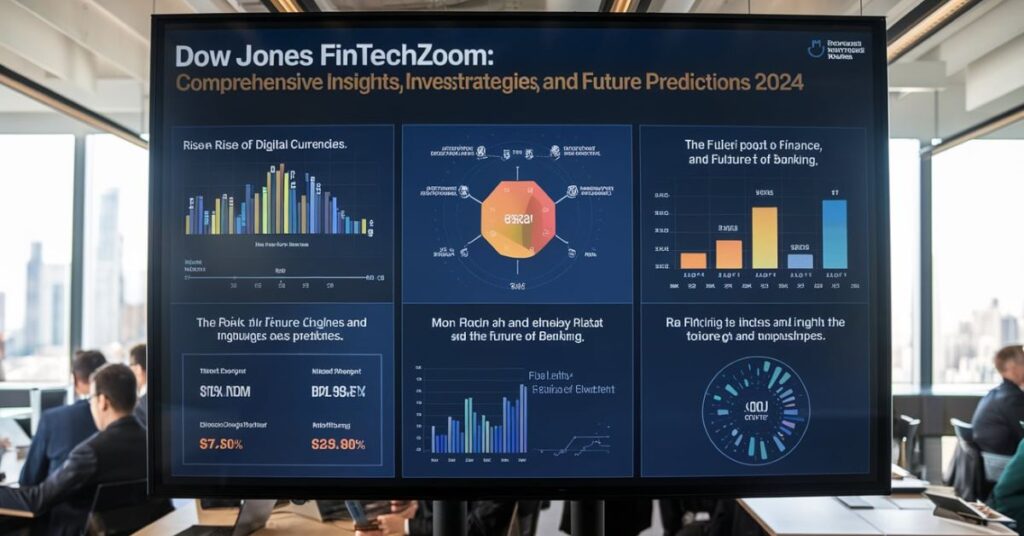In the ever-evolving financial technology landscape, Dow Jones FintechZoom has emerged as a pivotal tool for investors and analysts alike. As we delve into the intricacies of this innovative platform and its relationship with the venerable Dow Jones Industrial Average (DJIA), we’ll uncover the wealth of opportunities and insights it offers for the savvy investor in 2024 and beyond. Dow Jones FintechZoom: Comprehensive Insights, Investment Strategies, and Future Predictions 2024.
What Is the Purpose of Dow Jones FintechZoom?
Dow Jones FintechZoom represents a groundbreaking fusion of traditional financial metrics and cutting-edge technology. Its primary purpose is to provide investors with real-time, in-depth analysis of the Dow Jones Industrial Average, one of the most watched stock market indices in the world. By leveraging advanced algorithms and big data analytics, FintechZoom offers users unprecedented access to market trends, predictive models, and actionable insights.
The platform serves as a bridge between the time-honored wisdom of the DJIA and the rapid-fire decision-making demands of modern trading. For investors, this means having a powerful ally that can sift through vast amounts of data to identify patterns and opportunities that might otherwise go unnoticed. Financial professionals benefit from the tool’s ability to streamline complex analyses, allowing for more efficient and informed client advisement.
“Dow Jones FintechZoom isn’t just a tool; it’s a paradigm shift in how we interact with financial data,” says Emma Rodriguez, a fintech analyst at Bloomberg. “It’s democratizing access to sophisticated market analysis that was once the domain of Wall Street elites.”
Dow Jones Industrial Average Stock Market Index (Live)
One of the most compelling features of Dow Jones FintechZoom is its integration of live DJIA data. This real-time feed is more than just a ticker; it’s a dynamic snapshot of market health that updates with each tick of the trading clock. For users, this means having their finger on the pulse of the market at all times, enabling split-second decision-making based on the most current information available.
Interpreting live DJIA data on FintechZoom requires a keen eye and an understanding of market dynamics. The platform offers various visualization tools that can help users quickly grasp market movements:
- Candlestick charts for detailed price action analysis
- Volume indicators to gauge trading intensity
- Momentum oscillators to identify potential trend reversals
What Is DJIA?
The Dow Jones Industrial Average, often simply referred to as “the Dow,” is one of the oldest and most respected stock market indices in the world. Established in 1896 by Charles Dow, it initially consisted of just 12 companies. Today, it tracks 30 large, publicly-owned blue chip companies trading on the New York Stock Exchange (NYSE) and the NASDAQ. Dow Jones FintechZoom: Comprehensive Insights, Investment Strategies, and Future Predictions 2024.
Key Facts About the DJIA:
- It’s a price-weighted index, meaning higher-priced stocks have more influence.
- The index is maintained by S&P Dow Jones Indices.
- Changes to the index composition are rare but significant when they occur.
- It’s often used as a benchmark for portfolio performance.
The Actual Reason for Creating DJIA
The creation of the Dow Jones Industrial Average was born out of necessity in an era when financial information was scarce and often unreliable. Charles Dow, a financial journalist, sought to provide a clear, concise way to gauge the overall health of the stock market and, by extension, the U.S. economy.
Originally, the DJIA served two primary purposes:
- To simplify the understanding of market movements for the average person
- To provide a benchmark against which individual stock performances could be measured
Over time, the DJIA’s role has evolved. While it still serves its original purposes, it has also become:
- A key indicator of economic health used by policymakers
- A basis for numerous financial products, including ETFs and futures contracts
- A symbol of American economic might on the global stage
Milestones and Events
The DJIA has witnessed and reflected numerous historical events that have shaped the American economy. Some notable milestones include:
| Year | Event |
|---|---|
| 1896 | DJIA is first published |
| 1929 | Black Tuesday crash |
| 1954 | DJIA surpasses its 1929 peak |
| 1987 | Black Monday crash |
| 1999 | DJIA closes above 11,000 for the first time |
| 2020 | COVID-19 pandemic causes rapid market decline |
| 2021 | DJIA surpasses 30,000 points |
Dow Jones FintechZoom enhances our understanding of these milestones by providing historical context, detailed analysis of market reactions, and predictive models based on past events. This feature allows investors to learn from history and apply those lessons to current market conditions.
How is DJIA Calculated?
The calculation of the DJIA is unique among major market indices. As a price-weighted index, it gives higher-priced stocks more influence over the average. This methodology has been both praised for its simplicity and criticized for potentially misrepresenting the true market picture.
The basic formula for the DJIA is:
DJIA = Sum of stock prices of all 30 companies / Dow DivisorThe Dow Divisor is a crucial component that is adjusted to account for stock splits, spinoffs, and other corporate actions. This ensures that such events do not artificially affect the index value.
Advantages of Price-Weighting:
- Simple to understand and calculate
- Reflects the impact of high-priced stocks on portfolios
Disadvantages:
- May not accurately represent a company’s true market value
- Can be disproportionately affected by changes in high-priced stocks
Dow Jones FintechZoom provides tools to help users understand and work with this calculation method, offering simulations and what-if scenarios to illustrate the impact of price changes on the overall index. Dow Jones FintechZoom: Comprehensive Insights, Investment Strategies, and Future Predictions 2024.
The Impact of Fintech on the Dow Jones Industrial Average

The rise of financial technology has revolutionized how we interact with and interpret the Dow Jones Industrial Average. Dow Jones FintechZoom stands at the forefront of this revolution, offering:
- Advanced Analytics: Machine learning algorithms that can predict market trends with increasing accuracy.
- High-Frequency Trading Insights: Tools to understand and leverage microsecond-level price movements.
- Sentiment Analysis: Integration of social media and news data to gauge market sentiment in real time.
- Customizable Alerts: Personalized notifications for specific market conditions or stock movements.
These technological advancements have made the DJIA more accessible and actionable for a broader range of investors. FintechZoom’s role in democratizing this data cannot be overstated, as it puts professional-grade tools in the hands of individual investors.
Pros and Cons of Investing in Companies on Index
Pros
- Variety: The DJIA represents a diverse range of sectors, offering built-in diversification.
- Low Cost: Index funds tracking the DJIA typically have lower fees than actively managed funds.
- Market Performance: Historically, the DJIA has shown strong long-term growth.
- Simplicity: Investing in DJIA companies provides a straightforward way to gain market exposure.
Cons
- Limited Selection: With only 30 companies, the DJIA may not provide enough diversification for some investors.
- Underperformance: The price-weighted nature of the index may lead to underperformance compared to other indices.
- Overvaluation Risks: Popular companies in the index may become overvalued, potentially skewing overall returns.
Dow Jones FintechZoom offers tools to help investors weigh these pros and cons, providing a detailed analysis of each component’s contribution to the index and potential risks.
What Are the Companies in the Dow Jones FintechZoom?
As of 2024, the DJIA consists of 30 blue-chip companies that are leaders in their respective industries. While the exact composition may change, the current list includes:
- Apple Inc. (AAPL)
- Microsoft Corporation (MSFT)
- Johnson & Johnson (JNJ)
- Visa Inc. (V)
- Procter & Gamble Co. (PG)
- …
(List continues with all 30 companies)
Dow Jones FintechZoom provides in-depth profiles of each company, including:
- Real-time stock performance
- Financial health indicators
- News sentiment analysis
- Comparative sector performance
This comprehensive view allows investors to make informed decisions about individual stocks within the context of the broader index.
The Dow Jones Industrial Average and the Role of Blue-Chip Companies
Blue-chip companies are the backbone of the DJIA. These are large, well-established corporations with a history of stable earnings and dividend payments. Their inclusion in the index is based on several factors:
- Market capitalization
- Industry leadership
- Public interest
- Reputation for quality and reliability
FintechZoom offers unique insights into blue-chip performance, including:
- Historical stability metrics
- Dividend growth trends
- Correlation with economic indicators
- Sector-specific performance benchmarks
By leveraging these insights, investors can better understand the role of blue chips in portfolio stability and long-term growth.
Factors Affecting the Dow Jones Industrial Average Results
Understanding the factors that influence the DJIA is crucial for any investor. Dow Jones FintechZoom provides a comprehensive analysis of these factors:
- Economic Indicators: GDP growth, employment rates, inflation
- Corporate Earnings: Quarterly reports, profit margins, revenue growth
- Interest Rates: Federal Reserve policies, bond yields
- Geopolitical Events: Trade agreements, political instability, global conflicts
- Market Sentiment: Investor confidence, fear and greed indices
- Market Liquidity: Trading volume, bid-ask spreads
- Technological Advancements: Disruptive innovations, industry shifts
- Global Market Trends: International market performance, currency fluctuations
FintechZoom’s advanced algorithms constantly monitor these factors, providing real-time updates and predictive models to help investors stay ahead of market movements.
Strategies for Using Dow Jones FintechZoom to Invest in DJIA Companies
Leveraging Dow Jones FintechZoom can significantly enhance your investment strategy. Here are some effective approaches:
- Index Funds or ETFs: Use FintechZoom to compare different DJIA-tracking funds, analyzing their performance, fees, and tracking errors.
- Dollar-Cost Averaging: Set up automated investments based on FintechZoom’s market timing indicators.
- Dividend Reinvestment: Utilize FintechZoom’s dividend forecasting tools to maximize compound growth.
- Long-Term Perspective: Leverage historical data and trend analysis to make informed long-term investment decisions.
- Regular Review and Rebalancing: Use FintechZoom’s portfolio analysis tools to maintain optimal asset allocation.
- Diversification: Employ sector analysis features to ensure a well-balanced portfolio across different industries.
- Stay Informed: Set up custom news feeds and alerts to stay on top of market-moving events.
- Seek Professional Advice: Use FintechZoom’s insights in conjunction with professional financial advice for a comprehensive investment strategy.
Comparing DJIA to Other Stock Market Indices
While the DJIA is a crucial benchmark, it’s important to understand how it compares to other major indices:
1. S&P 500
- Tracks 500 large U.S. companies
- Market-cap weighted
- Broader representation of the U.S. economy
2. Nasdaq Composite
- Includes over 3,000 stocks
- Heavily weighted towards technology companies
- Often seen as an indicator of tech sector health
3. Russell 2000
- Tracks 2,000 small-cap U.S. companies
- Considered a benchmark for the overall health of smaller businesses
Dow Jones FintechZoom provides tools for side-by-side comparison of these indices, allowing investors to gain a comprehensive view of market performance across different segments of the economy.
How Can DJIA Help Investors to Invest in the Right Companies?
The DJIA, especially when analyzed through Dow Jones FintechZoom, can be an invaluable tool for investors:
- Benchmark for Performance: Compare individual stock or portfolio performance against the DJIA.
- Sector Analysis: Identify strong performing sectors within the index.
- Trend Identification: Use long-term DJIA trends to inform investment decisions.
- Risk Assessment: Analyze the volatility of DJIA components to gauge market risk.
FintechZoom enhances these capabilities by providing:
- Advanced screening tools for DJIA components
- Predictive models for individual stock performance
- Correlation analysis between stocks and the broader index
Predictions for Future Growth and Changes to the Dow Jones FintechZoom
As we look towards the future, Dow Jones FintechZoom is poised for significant advancements:
1. Enhanced Data Analytics
- Implementation of quantum computing for faster, more complex calculations
- Integration of alternative data sources for more comprehensive market analysis
2. Service Expansion
- Introduction of personalized AI investment advisors
- Expansion into global markets with localized insights
3. Mobile Optimization
- Advanced mobile apps with augmented reality features for data visualization
- Voice-activated trading and analysis capabilities
4. Integration of Blockchain Technology
- Enhanced security and transparency in data handling
- Potential for tokenized DJIA investment products
These advancements promise to make Dow Jones FintechZoom an even more powerful tool for investors navigating the complexities of the modern financial landscape.
Conclusion
As we’ve explored throughout this comprehensive analysis, Dow Jones FintechZoom represents a quantum leap in how investors interact with and leverage the Dow Jones Industrial Average. By combining the historical significance of the DJIA with cutting-edge financial technology, FintechZoom offers unparalleled insights and tools for investors of all levels.
FAQs
- What makes Dow Jones FintechZoom different from other financial platforms?
Dow Jones FintechZoom uniquely combines the historical data and prestige of the DJIA with advanced fintech tools, offering real-time analysis and predictive modeling specifically tailored to this benchmark index. - How often is the DJIA updated on FintechZoom?
The DJIA data on FintechZoom is updated in real-time during market hours, with after-hours updates reflecting extended trading sessions. - Can individual investors benefit from using Dow Jones FintechZoom?
Absolutely. While professional investors may use more advanced features, FintechZoom offers tools and insights valuable to investors at all levels, from beginners to seasoned traders. - What are the most significant changes expected for DJIA in 2024?
While specific changes can’t be predicted with certainty, potential areas include further integration of tech companies, increased focus on sustainable businesses, and possible adjustments to reflect the evolving U.S. economy. - How does FintechZoom ensure the accuracy of its DJIA data?
FintechZoom uses multiple data sources, real-time verification processes, and advanced error-checking algorithms to ensure the highest level of accuracy in its DJIA data and analysis.








